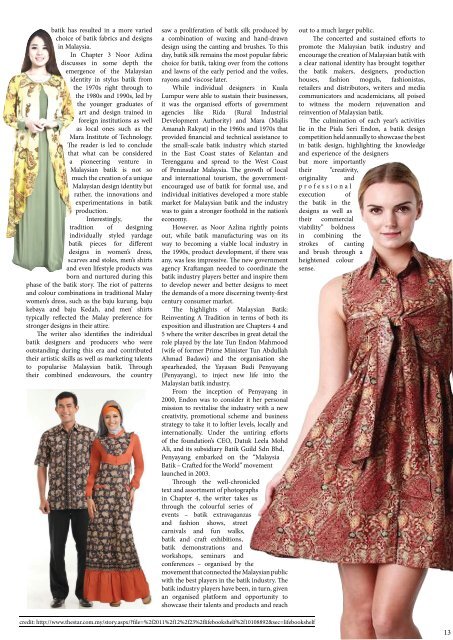You also want an ePaper? Increase the reach of your titles
YUMPU automatically turns print PDFs into web optimized ePapers that Google loves.
atik has resulted in a more varied<br />
choice of batik fabrics and designs<br />
in Malaysia.<br />
In Chapter 3 Noor Azlina<br />
discusses in some depth the<br />
emergence of the Malaysian<br />
identity in stylus batik from<br />
the 1970s right through to<br />
the 1980s and 1990s, led by<br />
the younger graduates of<br />
art and design trained in<br />
foreign institutions as well<br />
as local ones such as the<br />
Mara Institute of Technology.<br />
The reader is led to conclude<br />
that what can be considered<br />
a pioneering venture in<br />
Malaysian batik is not so<br />
much the creation of a unique<br />
Malaysian design identity but<br />
rather, the innovations and<br />
experimentations in batik<br />
production.<br />
Interestingly, the<br />
tradition of designing<br />
individually styled yardage<br />
batik pieces for different<br />
designs in women’s dress,<br />
scarves and stoles, men’s shirts<br />
and even lifestyle products was<br />
born and nurtured during this<br />
phase of the batik story. The riot of patterns<br />
and colour combinations in traditional Malay<br />
women’s dress, such as the baju kurung, baju<br />
kebaya and baju Kedah, and men’ shirts<br />
typically reflected the Malay preference for<br />
stronger designs in their attire.<br />
The writer also identifies the individual<br />
batik designers and producers who were<br />
outstanding during this era and contributed<br />
their artistic skills as well as marketing talents<br />
to popularise Malaysian batik. Through<br />
their combined endeavours, the country<br />
saw a proliferation of batik silk produced by<br />
a combination of waxing and hand-drawn<br />
design using the canting and brushes. To this<br />
day, batik silk remains the most popular fabric<br />
choice for batik, taking over from the cottons<br />
and lawns of the early period and the voiles,<br />
rayons and viscose later.<br />
While individual designers in Kuala<br />
Lumpur were able to sustain their businesses,<br />
it was the organised efforts of government<br />
agencies like Rida (Rural Industrial<br />
Development Authority) and Mara (Majlis<br />
Amanah Rakyat) in the 1960s and 1970s that<br />
provided financial and technical assistance to<br />
the small-scale batik industry which started<br />
in the East Coast states of Kelantan and<br />
Terengganu and spread to the West Coast<br />
of Peninsular Malaysia. The growth of local<br />
and international tourism, the governmentencouraged<br />
use of batik for formal use, and<br />
individual initiatives developed a more stable<br />
market for Malaysian batik and the industry<br />
was to gain a stronger foothold in the nation’s<br />
economy.<br />
However, as Noor Azlina rightly points<br />
out, while batik manufacturing was on its<br />
way to becoming a viable local industry in<br />
the 1990s, product development, if there was<br />
any, was less impressive. The new government<br />
agency Kraftangan needed to coordinate the<br />
batik industry players better and inspire them<br />
to develop newer and better designs to meet<br />
the demands of a more discerning twenty-first<br />
century consumer market.<br />
The highlights of Malaysian Batik:<br />
Reinventing A Tradition in terms of both its<br />
exposition and illustration are Chapters 4 and<br />
5 where the writer describes in great detail the<br />
role played by the late Tun Endon Mahmood<br />
(wife of former Prime Minister Tun Abdullah<br />
Ahmad Badawi) and the organisation she<br />
spearheaded, the Yayasan Budi Penyayang<br />
(Penyayang), to inject new life into the<br />
Malaysian batik industry.<br />
From the inception of Penyayang in<br />
2000, Endon was to consider it her personal<br />
mission to revitalise the industry with a new<br />
creativity, promotional scheme and business<br />
strategy to take it to loftier levels, locally and<br />
internationally. Under the untiring efforts<br />
of the foundation’s CEO, Datuk Leela Mohd<br />
Ali, and its subsidiary Batik Guild Sdn Bhd,<br />
Penyayang embarked on the “Malaysia<br />
Batik – Crafted for the World” movement<br />
launched in 2003.<br />
Through the well-chronicled<br />
text and assortment of photographs<br />
in Chapter 4, the writer takes us<br />
through the colourful series of<br />
events – batik extravaganzas<br />
and fashion shows, street<br />
carnivals and fun walks,<br />
batik and craft exhibitions,<br />
batik demonstrations and<br />
workshops, seminars and<br />
conferences – organised by the<br />
movement that connected the Malaysian public<br />
with the best players in the batik industry. The<br />
batik industry players have been, in turn, given<br />
an organised platform and opportunity to<br />
showcase their talents and products and reach<br />
out to a much larger public.<br />
The concerted and sustained efforts to<br />
promote the Malaysian batik industry and<br />
encourage the creation of Malaysian batik with<br />
a clear national identity has brought together<br />
the batik makers, designers, production<br />
houses, fashion moguls, fashionistas,<br />
retailers and distributors, writers and media<br />
communicators and academicians, all poised<br />
to witness the modern rejuvenation and<br />
reinvention of Malaysian batik.<br />
The culmination of each year’s activities<br />
lie in the Piala Seri Endon, a batik design<br />
competition held annually to showcase the best<br />
in batik design, highlighting the knowledge<br />
and experience of the designers<br />
but more importantly<br />
their “creativity,<br />
originality and<br />
p r o f e s s i o n a l<br />
execution of<br />
the batik in the<br />
designs as well as<br />
their commercial<br />
viability” boldness<br />
in combining the<br />
strokes of canting<br />
and brush through a<br />
heightened colour<br />
sense.<br />
credit: http://www.thestar.com.my/story.aspx/?file=%2f2011%2f12%2f23%2flifebookshelf%2f10108892&sec=lifebookshelf<br />
13



